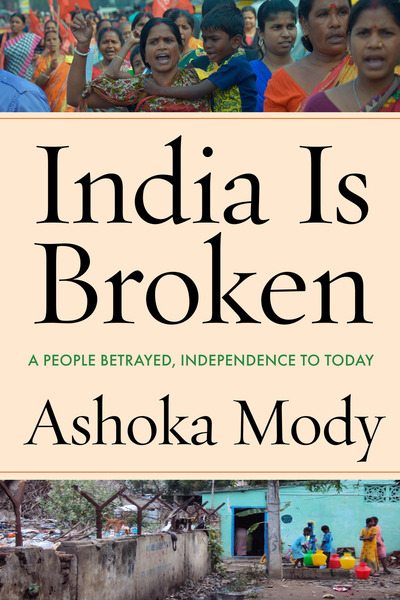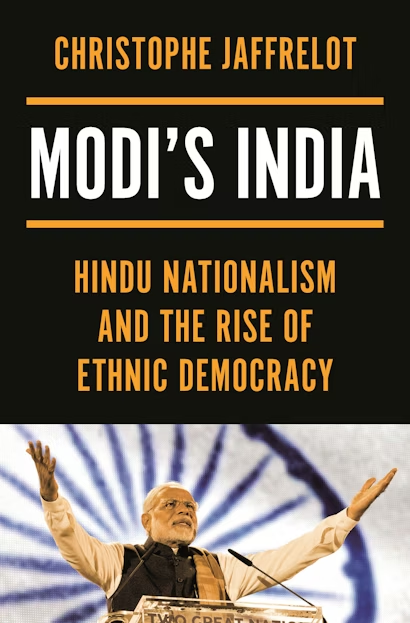
India is Broken: A People Betrayed, Independence to Today, by Ashoka Mody, Stanford University Press, Stanford, CA, 2023, 511 pages, Hardcover $35 ISBN: 798-1-5036-3005-5

Modi’s India: Hindu Nationalism and the Rise of Ethnic Democracy, by Christophe Jaffrelot, Princeton University Press, 2021, 639 pages, Softcover, $35 ISBN: 978-9391-234-843.
By Arnold Zeitlin
What is it with India? For years, if not decades, the country has been on the verge of great power status. It has already surpassed its great Asian rival, China, as the most populous country on earth. It is acclaimed, almost to the point of cliche, as the world’s largest democracy, the coming ideological, political, economic and military counterweight to China’s totalitarian presence.
But great power status has eluded India. Indians still are far from shaking and shaping the world the way the Chinese have.
Two authors suggest reasons why Christophe Jaffrelot, a French political scientist, in his Modi’s India weighs the onus on Narendra Modi, the country’s populist prime minister. Taking off on Modi from the beginning of his book for “promises made to the poor during election campaigns (that) did not translate into policies”. Jaffrelot is unrelentingly critical of the politician for another 400 pages.
Author Mody, a Princeton University professor of economics, covers much of the same ground under Modi but dives deeper into India’s history of independence. According to Mody’s India is Broken, India’s faltering descent began at the stroke of independence with the country’s revered founding prime minister, Jawaharlal Nehru, and continued with his family.
“Nehru lacked the political resolve, “Mody writes of early efforts to establish land reform, “to pursue the cause of an equal India,” concluding, “the unraveling of Indian democracy began gently under….Nehru.” Even before discussing the Modi years, Mody is harsh in his assessment of Nehru’s daughter Indira Gandhi and her son Rajiv Gandhi.
“Her years as prime minister are best regarded as an enormous missed opportunity,” Mody writes of Indira. “….India began losing the race to China…But Mrs. Gandhi’s years are even more important because of the damage she did to Indian democracy.”
“Rajiv was prime minister only because he was his mother’s son,” Mody adds, noting that Rajiv became prime minister “on the threshold of a surge in Hindutva — Hindu nationalism….Rajiv lacked the historical perspective and political skill to deal with such powerful tendencies. He naively tried to channel the gale force of Hindu nationalism to his political advantage. Instead, the force sucked him into its vortex.”
He doesn’t overlook Indira’s other son, Sanjay, who was to die young in the crash of an acrobatic plane he recklessly piloted. “A spoiled child with destructive instincts,” Mody writes. adding: “Sanjay’s breathtaking corruption was, in part, a response to his incompetence. His mother’s indulgence made it all possible. And he was now India’s prince.”
Assessments of Modi from both authors get no better.
“The bottom line is clear…,” asserts Mody, referring to Modi’s first term from 2014 as Prime Minister after serving as chief minister of Gujarat state, “the Gujarat ‘development model’ and Modi were singularly unsuited to tackle India’s needs.”
Modi’s capital-intensive development projects helped his billionaire chums (specifically Mukesh Ambani and Gautam Adani), writes Mody. “….but they did not create the jobs Modi and his acolytes had promised. The result: growth slowed, employment levels fell, poverty….very likely increased, and human development advanced barely, if at all….Inevitable the economy served the privileged while Indian democracy continued to unravel.”
Jaffrelot makes much the same points in chapter after chapter describing in detail how Modi and associates have manipulated legislation, used police pressure and government agencies such as the income tax department to intimidate as well as allowing vigilantism outside government to weaken the judiciary, the legislature, the civil service, the political opposition and any part of social society that might become opposition.
Jaffrelot, too, declares, “Under Narendra Modi, the rich have come richer, and inequalities have increased.”
The onus for all of this does not fall only on Modi. Two of the most high-level villains in Jaffrelot’s accounting are Amit Shah, now minister of home affairs and Mody’s close associate since their Gujarat days, and Yogi Adityanath, chief minister of Uttar Pradesh, the first Hindu monk to reach such an exalted political position.
The non-government organization that Jaffrelot lists as carrying out Modi’s Hindu nationalist agenda is the Sangh Parivar, an umbrella outfit that includes Modi’s Bharatiya Janata Party as well as the more wicked Rashtriya Swayamsevak Sangh or National Volunteer Organization, which Modi supposedly joined when he was eight years old. The RSS and other groups that spring from Sangh Parivar carry on without much restraint from Modi or anyone else to promote a Hindutva or Hindu nationalism that seems to require hostility and marginalization of the Muslim minority.
Jaffrelot spends considerable ink examining the promotion of so-called love jihad, a conspiracy, Hindu nationalists claim, in which “fanatic” Indian Muslim boys seduce innocent Hindu girls into marriage and conversion to Islam and then produce Muslim babies in an effort to overtake the Hindu population. There is also a “love gospel,” which, the Hindu nationalists say, lures Hindus into converting to Christianity. Hindu militants use persuasion, intimidation, and violence to save Hindu women. Yogi Adityanath created “anti-Romeo squads” to protect Hindu womanhood.
The approximately 15 percent of Indians who are Muslim are hardly the population threat to the approximately 80 percent of Indians listed as Hindu. Jaffrelot found no statistics on religious conversion. However, he cites a police report that of 229 girls reported missing between 2005 and 2009 but found married to a man of a different religion, 63 had converted, but not necessarily to Hinduism. Thirty-eight of the girls were now Muslims, 20 were Christian.
Amidst their denunciations of Modi, his crowd and his policies, neither author tries to explain the prime minister’s continued popularity, which hits the charts as high as 78 percent. Voters seem willing to slide with Modi from a secular India to a Hindu-majority state, with Muslims, particularly, as well as others as second-class citizens. The country would be no different in that religious sense from Muslim-majority Malaysia, which pursues a policy of Malay supremacy, giving privilege to the bumiputra or native Malays and making Chinese and Malaysian Indians second-class citizens or even India’s Muslim-majority neighboring antagonist, Pakistan.
Despite their indictment of Modi, the author of these two books may, without their realizing it, be charting the future of India.

